|
 |
|
 |
|
|
 |
|  |
|
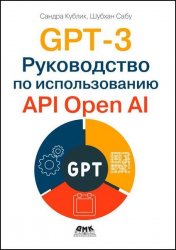 Название: GPT-3. Руководство по использованию API Open AI Название: GPT-3. Руководство по использованию API Open AI
Автор: Сандра Кублик, Шубхам Сабу
Издательство: ДМК Пресс
Год: 2023
Страниц: 174
Язык: русский
Формат: pdf
Размер: 10.3 MB
В книге исследуется мощная языковая модель GPT-3, упрощающая создание приложений с искусственным интеллектом. Первая часть посвящена основам API OpenAI, во второй описывается динамичная и процветающая среда, возникшая вокруг GPT-3. Представлены рекомендации по использованию GPT-3 для создания новых бизнес-продуктов. Обсуждается влияние GPT-3 на развитие мировой экономики и такие передовые тенденции, как программирование без кода и достижение общего искусственного интеллекта. Книга рассчитана на читателей, интересующихся современными технологиями. Она будет особенно полезна предпринимателям, деятельность которых связана с индустрией искусственного интеллекта, а также тем, кто планирует использовать языковые способности GPT-3 для реализации творческих проектов. Первая часть книги посвящена основам API OpenAI. Во второй части книги мы исследуем пеструю экосистему, органично и стремительно возникшую вокруг GPT-3. В главе 1 изложен контекст и основные определения, необходимые для комфортного изучения дальнейших тем. В главе 2 мы глубоко погружаемся в API, разбивая его на наиболее важные элементы, такие как базовые модели и конечные точки, описывая их назначение и способы использования для читателей, которые хотят взаимодействовать с ними на более глубоком уровне. Глава 3 содержит простой и интересный рецепт для вашего первого приложения на базе GPT-3. | |
Разместил: Ingvar16 10-04-2024, 03:03 | Комментарии: 0 | Подробнее
| | | |
 |
|  |
 |
|
 |
|
|
 |
|  |
|
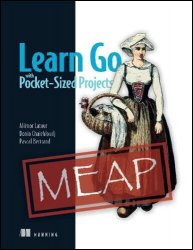 Название: Learn Go with Pocket-Sized Projects (MEAP v7) Название: Learn Go with Pocket-Sized Projects (MEAP v7)
Автор: Alienor Latour, Donia Chaiehloudj, Pascal Bertrand
Издательство: Manning Publications
Год: 2024
Страниц: 487
Язык: английский
Формат: pdf, epub
Размер: 10.1 MB
These small Go projects will build big Go skills! Learn hands-on as you build 11 engaging applications. Learn Go with Pocket-Sized Projects teaches you to write professional-level Go code by creating handy tools and fun apps. Each small, self-contained project introduces important practical skills, including ensuring that your code is thoroughly tested and documented! You’ll make architectural decisions for your projects and organize your code in a maintainable way. Everything you learn is easy to scale-up to full-size Go applications. Go delivers the low-level power of system languages like C and Rust with developer-friendly features like garbage collection and a powerful standard library. Millions of programmers choose Go because it speeds up program construction, streamlines dependency management, and makes complex code simple to write, read, and maintain. This book is for developers who want to learn the language in a fun and interactive way, and be comfortable enough to use it professionally. Each chapter is an independent pocket-sized project. The book covers the specificities of the language, such as implicit interfaces and how they help in test design. Testing the code is included throughout the book. We want to help the reader become a good modern software developer while using the Go language. This book also contains tutorials for command-line interfaces, and for both REST and gRPC microservices, showing how the language is great for cloud computing. It finishes with a project that uses TinyGo, the compiler for embedded systems. | |
Разместил: Ingvar16 10-04-2024, 00:58 | Комментарии: 0 | Подробнее
| | | |
 |
|  |
 |
|
 |
|
|
 |
|  |
|
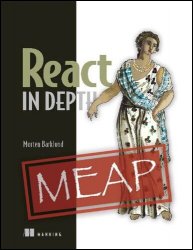 Название: React in Depth (MEAP v5) Название: React in Depth (MEAP v5)
Автор: Morten Barklund
Издательство: Manning Publications
Год: 2024
Страниц: 518
Язык: английский
Формат: pdf, epub
Размер: 40.3 MB
Put React to work with this must-have professional collection of advanced React libraries, techniques, and tools. React in Depth is a guide to the advanced React skills used by professional React developers. It focuses on the modern best practices of React development, with full and up-to-date coverage of the latest features and changes to the React ecosystem. This book highlights the techniques companies love to ask about at an interview, and how you can future-proof your career by mastering new React technologies as they emerge. You’ll learn the tools and techniques that are vital to build pro-level apps—and put them into practice with hands-on projects like a goal-focused task manager, expenses tracker, and custom UI library. The React framework boasts a huge ecosystem of libraries and tools that can help you deliver incredible results efficiently. This guide explores exactly what React pros need to know to get the most out of React, from optimizing performance to even creating full-stack web applications. You’ll learn how to put NextJS, Remix, TypeScript, and more in your React toolbox. For web developers familiar with the basics of React. | |
Разместил: Ingvar16 9-04-2024, 20:01 | Комментарии: 0 | Подробнее
| | | |
 |
|  |
 |
|
 |
|
|
 |
|  |
|
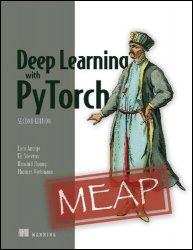 Название: Deep Learning with PyTorch, Second Edition (MEAP v3) Название: Deep Learning with PyTorch, Second Edition (MEAP v3)
Автор: Luca Antiga, Eli Stevens, Howard Huang
Издательство: Manning Publications
Год: 2024
Страниц: 273
Язык: английский
Формат: pdf, epub
Размер: 13.7 MB
Everything you need to create neural networks with PyTorch, including Large Language and diffusion models. Deep Learning with PyTorch, Second Edition updates the bestselling original guide with new insights into the transformers architecture and generative AI models. Instantly familiar to anyone who knows PyData tools like NumPy and Scikit-learn, PyTorch simplifies Deep Learning without sacrificing advanced features. In Deep Learning with PyTorch, Second Edition you’ll learn how to create your own neural network and Deep Learning systems and take full advantage of PyTorch’s built-in tools for automatic differentiation, hardware acceleration, distributed training, and more. PyTorch makes it easy to build the powerful neural networks that underpin many modern advances in Artificial Intelligence. This second edition has been thoroughly revised by PyTorch core developer Howard Huang to cover the latest features and applications, including generative AI models. The book is written for developers, students, or even hobbyists who have some prior experience with the Python programming language and want to gain a better understanding of Deep Learning. | |
Разместил: Ingvar16 9-04-2024, 19:31 | Комментарии: 0 | Подробнее
| | | |
 |
|  |
 |
|
 |
|
|
 |
|  |
|
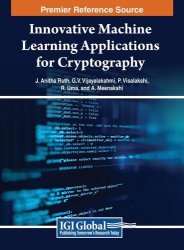 Название: Innovative Machine Learning Applications for Cryptography Название: Innovative Machine Learning Applications for Cryptography
Автор: J. Anitha Ruth, G.V. Vijayalakshmi, P. Visalakshi
Издательство: IGI Global
Год: 2024
Страниц: 313
Язык: английский
Формат: pdf (true), epub
Размер: 30.9 MB
Data security is paramount in our modern world, and the symbiotic relationship between Machine Learning and cryptography has recently taken center stage. The vulnerability of traditional cryptosystems to human error and evolving cyber threats is a pressing concern. The stakes are higher than ever, and the need for innovative solutions to safeguard sensitive information is undeniable. Innovative Machine Learning Applications for Cryptography emerges as a steadfast resource in this landscape of uncertainty. Machine Learning's prowess in scrutinizing data trends, identifying vulnerabilities, and constructing adaptive analytical models offers a compelling solution. The book explores how Machine Learning can automate the process of constructing analytical models, providing a continuous learning mechanism to protect against an ever-increasing influx of data. This book goes beyond theoretical exploration, and provides a comprehensive resource designed to empower academic scholars, specialists, and students in the fields of cryptography, Machine Learning, and network security. Its broad scope encompasses encryption, algorithms, security, and more unconventional topics like Quantum Cryptography, Biological Cryptography, and Neural Cryptography. By examining data patterns and identifying vulnerabilities, it equips its readers with actionable insights and strategies that can protect organizations from the dire consequences of security breaches. | |
Разместил: Ingvar16 9-04-2024, 17:45 | Комментарии: 0 | Подробнее
| | | |
 |
|  |
 |
|
 |
|
|
 |
|  |
|

Название: Генеративное глубокое обучение. Как не мы рисуем картины, пишем романы и музыку, 2-е межд. издание
Автор: Дэвид Фостер
Издательство: Спринт Бук
Год: 2024
Формат: pdf
Страниц: 448
Для сайта: Mirknig.su
Размер: 18,2 Мб
Язык: русский
Генеративный ИИ — одна из самых обсуждаемых тем в сфере технологий. Пора разобраться с возможностями TensorFlow и Keras, чтобы с легкостью создавать впечатляющие генеративные модели глубокого обучения, включая вариационные автокодировщики (VAE), генеративно-состязательные сети (GAN), трансформеры, нормализующие потоки, модели на основе энергии и диффузионные модели удаления шума. Дэвид Фостер, начинает с основ глубокого обучения и постепенно переходит к передовым архитектурам. Благодаря его советам и подсказкам вы узнаете, как повысить эффективность обучения и творческие возможности ваших моделей. Книга была полностью обновлена и переработана, чтобы соответствовать текущему развитию генеративного обучения. | |
Разместил: relizer 9-04-2024, 11:01 | Комментарии: 0 | Подробнее
| | | |
 |
|  |
 |
|
 |
|
|
 |
|  |
|
 Название: Линейное программирование. Теория и конечные методы. Название: Линейное программирование. Теория и конечные методы.
Серия: Физико-математическая библиотека инженера
Автор: Давид Борисович Юдин и Евгений Григорьевич Гольштейн
Издательство: Государственное издательство физико-математической литературы
Год: 1963
Страниц: 776
Формат: pdf и djvu
Качество: хорошее
Размер файла: 26.59 MB
Язык: русский
Линейное программирование дает способы находить наиболее выгодные варианты при планировании производства, перевозок и снабжения и при управлении сложными процессами. Внедрение методов линейного программирования в практику позволяет достичь значительной экономии средств и времени.
В настоящей книге подробно излагаются математическая теория линейного программирования и вычислительные методы, позволяющие находить точное решение задачи за конечное число шагов. | |
Разместил: balik2 9-04-2024, 07:41 | Комментарии: 0 | Подробнее
| | | |
 |
|  |
 |
|
 |
|
|
 |
|  |
|
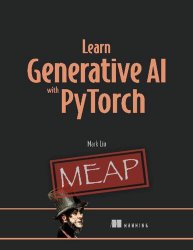 Название: Learn Generative AI with PyTorch (MEAP v2) Название: Learn Generative AI with PyTorch (MEAP v2)
Автор: Mark Liu
Издательство: Manning Publications
Год: 2024
Страниц: 298
Язык: английский
Формат: pdf, epub
Размер: 52.8 MB
Create your own generative AI models for text, images, music, and more! Generative AI tools like ChatGPT, Bard, and DALL-E have transformed the way we work. Learn Generative AI with PyTorch takes you on an incredible hands-on journey through creating and training AI models using Python, the free PyTorch framework and the hardware you already have in your office. Along the way, you’ll master the fundamentals of General Adversarial Networks (GANs), Transformers, Large Language Models (LLMs), variational autoencoders, diffusion models, LangChain, and more! All generative models in this book are deep neural networks. The book starts with a comprehensive Deep Learning project in PyTorch, ideal for those new to the field. Each chapter is carefully structured to build upon the previous one, especially beneficial for readers new to Deep Learning in PyTorch. You'll start by creating basic content like shapes, numbers, and images using Generative Adversarial Networks (GANs) with straightforward architectures. As you progress, the complexity increases, culminating in building advanced models like Transformers. | |
Разместил: Ingvar16 9-04-2024, 05:43 | Комментарии: 0 | Подробнее
| | | |
 |
|  |
 |
|
 |
|
|
 |
|  |
|
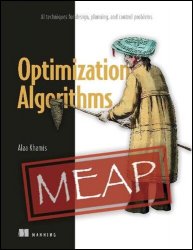 Название: Optimization Algorithms (MEAP v12) Название: Optimization Algorithms (MEAP v12)
Автор: Alaa Khamis
Издательство: Manning Publications
Год: 2024
Страниц: 739
Язык: английский
Формат: epub
Размер: 77.6 MB
Solve design, planning, and control problems using modern machine learning and AI techniques. Optimization problems are everywhere in daily life. What’s the fastest route from one place to another? How do you calculate the optimal price for a product? How should you plant crops, allocate resources, and schedule surgeries? Optimization Algorithms introduces the AI algorithms that can solve these complex and poorly-structured problems. Inside you’ll find a wide range of optimization methods, from deterministic and stochastic derivative-free optimization to nature-inspired search algorithms and machine learning methods. Don’t worry—there’s no complex mathematical notation. You’ll learn through in-depth case studies that cut through academic complexity to demonstrate how each algorithm works in the real world. | |
Разместил: Ingvar16 9-04-2024, 05:03 | Комментарии: 0 | Подробнее
| | | |
 |
|  |
 |
|
 |
|
|
 |
|  |
|
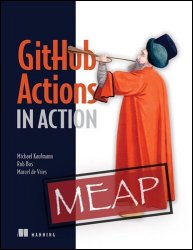 Название: GitHub Actions in Action (MEAP v2) Название: GitHub Actions in Action (MEAP v2)
Автор: Michael Kaufmann, Rob Bos, Marcel de Vries
Издательство: Manning Publications
Год: 2024
Страниц: 139
Язык: английский
Формат: pdf, epub
Размер: 17.5 MB
Automate your build, test, and deploy pipelines using GitHub Actions! Continuous delivery (CI/CD) pipelines help you automate the software development process and maximize your team’s efficiency. GitHub Actions in Action teaches you to build real-world build, test, and deploy pipelines in GitHub Actions through hands-on labs and projects. GitHub Actions in Action shows you exactly how to implement a secure and reliable continuous delivery process with just the tools available in GitHub—no complex CI/CD frameworks required! You’ll follow an extended example application for selling tickets, taking it all the way from initial build to cloud deployment. The first part of the book introduces the basics of workflows and actions, all illustrated with simple examples. You’ll then move on to the platform’s architecture, security considerations, and in-depth coverage of the workflow runtime. Finally, you’ll learn how to deliver a complete CI/CD pipeline, including compliance and performance and costs optimization. You’ll even learn to create your own actions that you can share in the GitHub marketplace! For software developers and DevOps engineers already working with GitHub and looking to expand to GitHub Actions. | |
Разместил: Ingvar16 9-04-2024, 04:36 | Комментарии: 0 | Подробнее
| | | |
 |
|  |
|